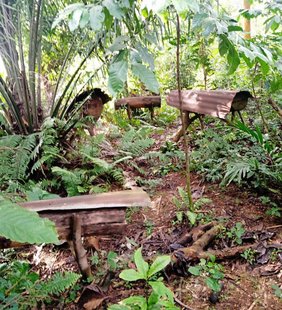The Beekeeping Project in Sarambwe Nature Reserve
Categories: Journal no. 66, Democratic Republic of the Congo, Sarambwe, Mountain Gorilla
Support for this project was requested because of strong demand from the local population of Rutshuru and Nyiragongo and the city of Goma, due to a shortage in these areas, and also in view of the beneficial qualities of honey: taste, therapeutic, cosmetic, protective, digestive, calming and respiratory. The beekeepers extract honey and make a profit from the sale, thus acquiring the means to meet their household needs and those of their dependants.
The main therapeutic properties of honey are as follows:
- Anti-infection, antibiotic, scar healing: honey has a weak concentration of protein and a moderately elevated acidity (pH 3.2-4.5), which blocks bacterial development. It also contains glucose oxidase; this enzyme produces hydrogen peroxide, a natural antiseptic that has the same effect as oxygenated water. Applied to wounds, honey absorbs fluids, drawing lymph and plasma out of the body, draining the wound. This helps the body to eliminate waste products, clean and heal wounds.
- Taste: honey is used as an ingredient for cakes, in sauces and to sweeten tea and coffee.
- Cosmetic properties: honey is a hydrating product that softens and tones the skin. Its hydrating properties help to nourish and renew skin cells, maintaining a youthful skin. It is much used in cosmetic products such as skin oils, shower gels and hair gels.
- Digestive, respiratory and sedative qualities: honey affects the digestive system and, thanks to its antibiotic and healing properties, is effective in treating stomach and intestinal infections, reducing inflammations and alleviating stomach ulcers. It aids sleep, helps to improve coughs and sore throats, and calms the respiratory system.
Beekeeping: profitability, parasites and enemies
Due to the properties set out above, beekeeping is an income-generating activity. Honey makes money. A litre of good-quality honey sells for US$ 6-7 in Goma. Around the Sarambwe Reserve, honey is produced during two seasons (see below). The average production is 4-7 l per modern hive and 2-3 l per traditional hive, although it can be as low as 2 l per modern and 1 l per traditional hive.
It should be noted that hard work is required to succeed as a beekeeper. For example, the choice of terrain for positioning the hives is very important. Several factors can have a negative effect on honey production or lead to the beehives being abandoned. These include:
- Human factors: hives placed near a village are often faced with problems such as children throwing stones, conflict with villagers and farmers who claim that the bees will sting them or their livestock (goats, pigs, cows). Some people with bad intentions drive the bees from their hives, using simple methods such as putting down plants whose smell the bees dislike or putting harmful insects in the hives.
- Predation: the positioning of the hives must take into account bee predators, notably insectivorous birds like bee-eaters and reptiles such as agamas.
The Sarambwe bee project
The project was inspired by the benefits described above. Thirty modern and thirty traditional hives were produced and distributed to two groups of beekeepers and a local women's association in Sarambwe and Kisharu. Production is expected to reach 340-510 litres of honey per year, with two harvests - after the rainy season and at the beginning of the short dry season. The larger amount of honey will be produced in January-February, with a lesser production in July-August. Five litres of honey sell at US$ 30 local wholesale price, which represents an injection of US$ 2040-3060 per year in the area, if all the honey is sold.
How the reserve benefits
This project reinforces collaboration between the community and the reserve. It enables managers to retain the monitoring system already in place, whereby the population report illegal activity in the reserve, including cultivation, sawing, poaching, wood-cutting and bushfires. A key area of negotiation is raising awareness among poachers of the advantages of abandoning their hunting and trapping. Since the beginning of the war between the Congolese armed forces and the rebel movement known as M23, all the police, soldiers and local authority workers have left the area and taken refuge in the city of Goma. With no-one capable of punishing the poachers, they consider themselves free to carry on their destructive activities in the reserve.
Thanks to the Dialogue Committee and the presence of the local elders, we are in the process of negotiating ways that poachers can benefit from the bee-keeping project in exchange for surrendering to the elders the 'tools of their trade' - spears, arrows and snares. These negotiations are going well. The poachers seem to agree, we are succeeding in convincing them. However, presently there are no hives left for distribution. Extra funding would enable us to help the poachers as well. If forthcoming, we will make great strides towards the safeguarding of the biodiversity of the Sarambwe Reserve.
Claude Sikubwabo Kiyengo

